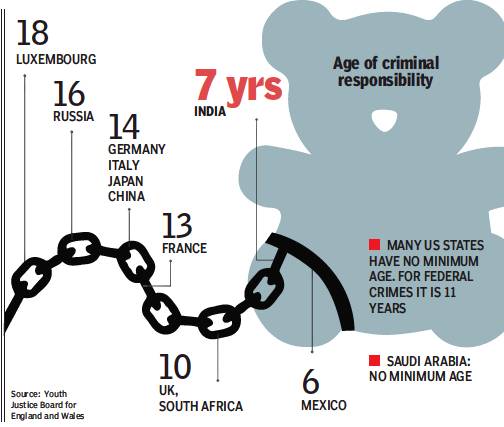Criminal liability: India
This is a collection of articles archived for the excellence of their content. |
What is criminal liability?
Criminal act is not the same as criminal liability
Why criminal act is not the same as criminal liability, November 20, 2017: The Times of India

From: Why criminal act is not the same as criminal liability, November 20, 2017: The Times of India

From: Why criminal act is not the same as criminal liability, November 20, 2017: The Times of India
The father of the victim in the Ryan school murder has demanded that the juvenile accused in the case be tried as an adult. Post the Nirbhaya case, the amended Juvenile Justice Act allows juveniles above 16yrs to be tried as adults. A lowdown of laws across the world
What is the minimum age of criminal responsibility?
In common law, criminal liability is tested by actus reus (guilty act) and mens rea (guilty mind). This means that a criminal act alone doesn’t warrant criminal liability. The prosecution is required to prove that the person committing the crime was mentally sound to realise the act was wrong. There is no global standard of minimum age where a child can be deemed to be mature enough to recognise consequences of a crime, but most countries have a minimum age of criminal responsibility (CR) below which it is presumed a child is incapable of committing a crime and cannot be punished.
Can people above the CR age be tried as adults? And what is ‘criminal majority’?
People just above the CR age can’t be tried as adults. Many countries have a much higher age of ‘criminal majority’ — typically age
18. If a person between the age of criminal responsibility and criminal majority commits a crime he/she is protected by the country’s juvenile justice system and typically isn’t required to serve sentences alongside adults.
In India, the Juvenile Justice Act of 2000 that took reformative approach towards juveniles under the age 18 was replaced by the Juvenile Justice (Care and Protection of Children) Act 2015. The new act allows children aged 16 to 18 years to be tried as adults for heinous offences. In the US, many states allow juveniles to be tried as adult if they have committed heinous crimes.
In 2001, 14-year-old Lionel Tate was sentenced to life in prison without possibility of parole for murdering a 6-year-old girl in 1999. Tate was only 12 at the time of the crime and became the youngest person in the US to get such a severe sentence.
Has there been a steady increase in crimes by juveniles?
According to National Crime Records Bureau, the rate of crimes committed by juveniles and the total number of cases against them declined in 2015 compared to 2014. Compared to 2005, the crime rate has increased. However, juvenile crime as a proportion of all crimes has remained at about 1%.